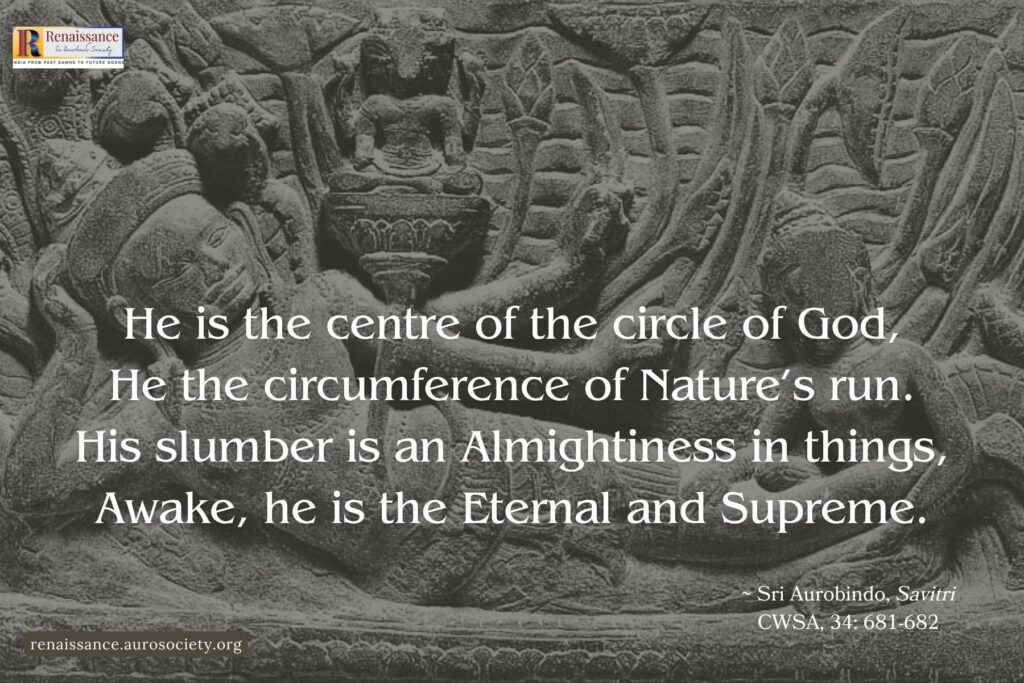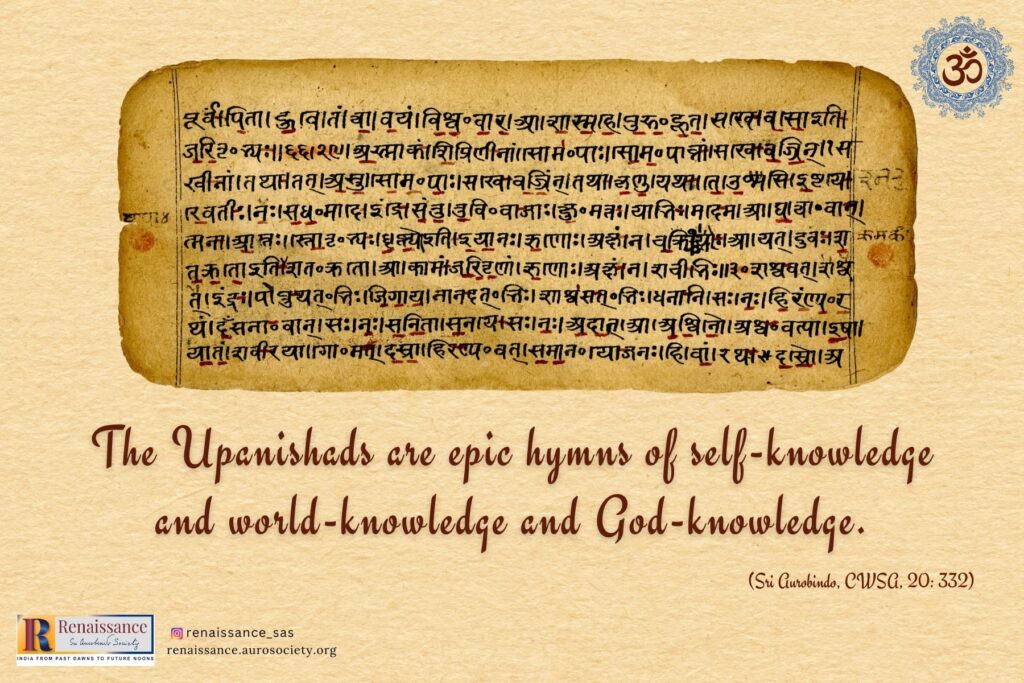Editor’s note: We present selected conversations of Sri Aurobindo with a few disciples in which the matter of peace came up.
These are excerpted from Nirodbaran’s Talks with Sri Aurobindo, Vols. 1 and 2, published by Sri Aurobindo Ashram in 2001. We have made a few minor formatting revisions for the purpose of digital presentation.


“They may get disturbed by the complex working here.”
PURANI: A Kashmiri Brahmachari has come for Darshan. He was lying near the gate at night. He seems to have done Rajayoga and had some experiences.
SATYENDRA: He seems to be a fine personality.
NIRODBARAN: Person or personality?
SATYENDRA: Personality – the physical…
SRI AUROBINDO: Oh, the physical?
SATYENDRA: I was more concerned about his belongings. Somebody could have taken them away while he was sleeping outside the gate.
SRI AUROBINDO: You mean some of our innocent servants who don’t know what they are doing? (Laughter)
PURANI: He says he has lost his peace and has come in search of it.
SRI AUROBINDO: For peace he can go to Ramana Maharshi. When people come here for peace I always ask them to go to him.
NIRODBARAN: Why? Can’t they get peace here?
SATYENDRA: They may even lose whatever peace they have!
SRI AUROBINDO: They may get disturbed by the complex working here.
SATYENDRA: Here peace is not the main object. In the Mother’s Conversations, the first thing she says is: “What do you want Yoga for? For peace? It is not enough.” At the Maharshi’s place it is different. People do get peace there because it is almost the main thing.
CHAMPAKLAL: One really can’t get peace here if one wants it?
SRI AUROBINDO: It depends on the person. Europeans who come here get peace, they say. It is because they come with an agitated mind, I suppose.
~ 10th March 1940: Talks with Sri Aurobindo, Vol. 2, p. 542
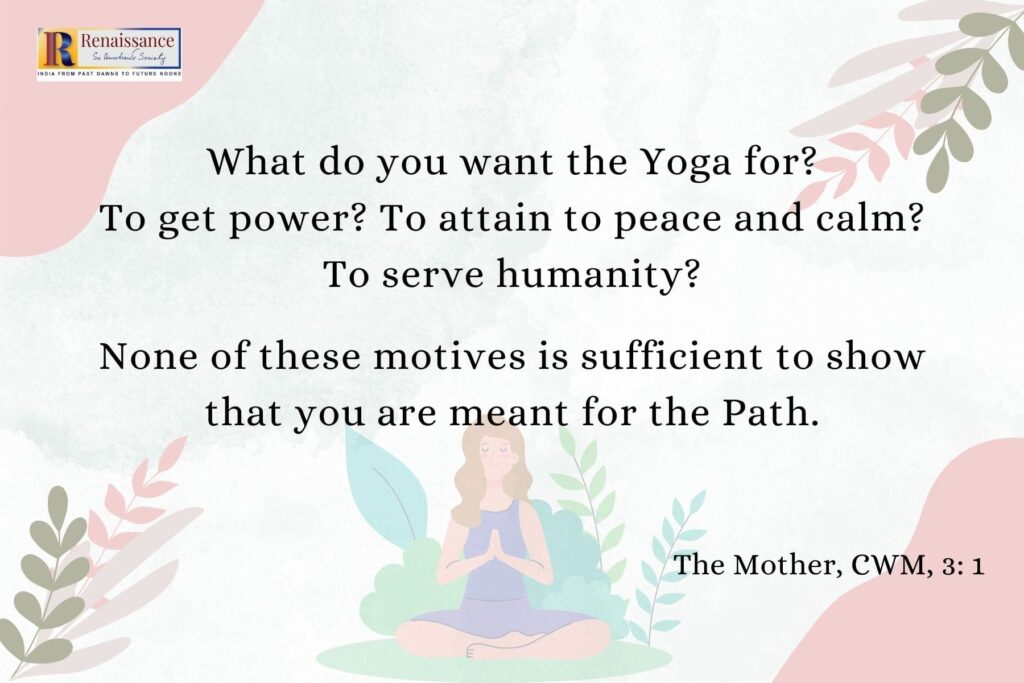

Peace, Silence, Emptiness
DR. BECHARLAL: What is the difference between peace and silence?
SRI AUROBINDO: How do you mean?
DR. BECHARLAL: Is peace included in silence, or vice versa?
SRI AUROBINDO: If you have the silence, then there is naturally peace with it; but the opposite may not be true. One can do a lot of work with the peace within.
NIRODBARAN: Can one do work with the silence intact? Does not the silence get disturbed?
SRI AUROBINDO: Certainly one can do work. By silence I mean inner silence. It is perfectly possible to carry on any amount of activity in that state. I told you about my experience, which is still with me. It has not been disturbed by any activity.
DR. BECHARLAL: Is silence dynamic or static?
SRI AUROBINDO: It is not the silence that is dynamic but you can have full dynamic activity out of the inner silence. Also you can remain without doing anything. People who are kinetic in a vital or mental way cannot remain like that.
Some Marathas came to see me here and inquired what I was doing. I replied, “Nothing.” One of them remarked that it was a great thing to do nothing. This is true.
NIRODBARAN: Isn’t the silence associated with some sort of emptiness?
SRI AUROBINDO: It depends on what you mean by emptiness. There is an emptiness which is full of the divine Presence and can hardly be called empty. There is another emptiness of silence which is neutral and still another in which one empties oneself, waiting for something higher to come and fill it.
NIRODBARAN: In that emptiness one feels somewhat dry, doesn’t one?
SRI AUROBINDO: No. On the contrary it is a very pleasant state, with a sense of great release. The neutral silence may be associated with some dryness and dullness—to the ordinary mind.
NIRODBARAN: It seems you said once to Barin, when he was having such emptiness and dryness, that it comes to everybody and he had to pass through that phase or stage.
SRI AUROBINDO: Well, it need not come to everybody, but when it does come to somebody he has to pass through it. People like Bertrand Russell can’t bear this emptiness. He says that as soon as he tries to go within he begins to feel empty and wants to come back. It is foolish on his part to want to come back, for if he is able to feel this emptiness it is something good, the sign of a valuable capacity.
These Europeans can’t do without thought and the external interests of life. They think that nothing of value can come into the consciousness except from outside.
2nd January 1939, Talks with Sri Aurobindo, Vol. 1, pp. 92-93

Withdrawal, Peace and Spiritual Dynamism
NIRODBARAN: How far can withdrawal be useful in sadhana?
SRI AUROBINDO: Mere withdrawal is not enough. A man may separate himself from the contacts of the world but it doesn’t mean that all his desires and hankerings have ceased.
If you simply withdraw without throwing away the seeds of attachment and don’t replace the ordinary by the spiritual consciousness, the problem remains unsolved. If you permit the seeds to remain, they may keep quiescent for a time but as soon as circumstances present themselves they may come up.
Withdrawal may lead to a neutral state but that is not our Yoga. We want spiritual dynamism as the source of action.
NIRODBARAN: If one writes about metaphysics or philosophy with a spiritual attitude the spiritual consciousness must be there.
SRI AUROBINDO (laughing): Must it? Attitude is not enough. There must be an inner change too. Of course if one wrote from his personal experience and vision it would be different. But remaining withdrawn need not lift one into the spiritual consciousness: one may very well be in the mental consciousness. Philosophical writings are of the mental plane.
NIRODBARAN: Calm and peace may be there behind.
SRI AUROBINDO: That is not sufficient. There must be the spiritual dynamism too, which would be projected into all the activities.
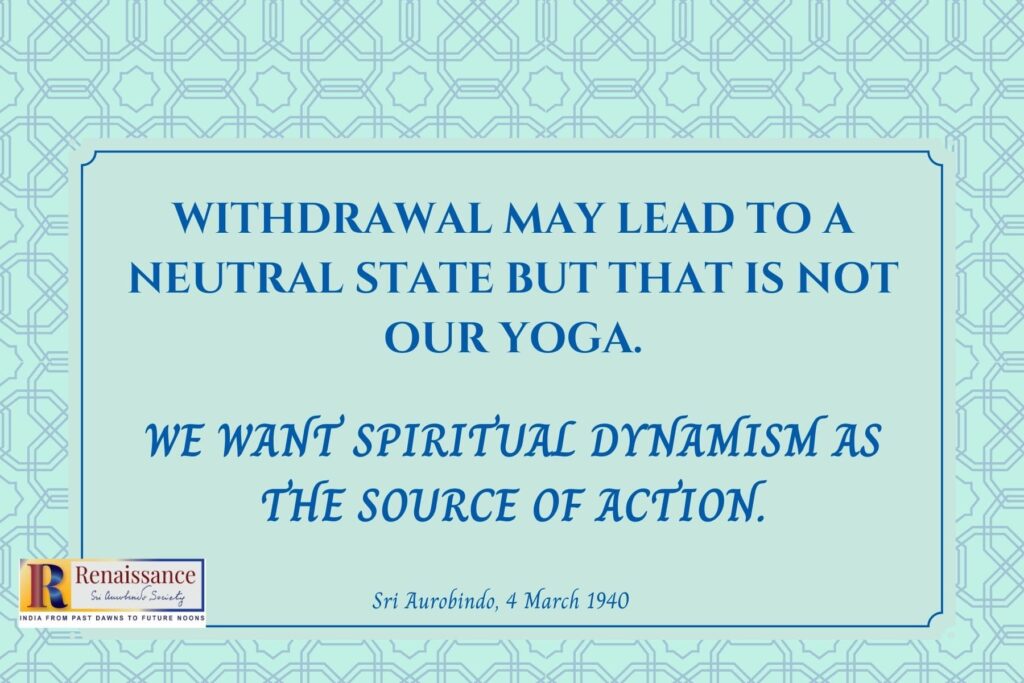
SATYENDRA: There are many people who have peace or have experienced a descent of peace into them – solid peace which is the peace of Brahman. (To Nirodbaran) You had it yourself.
NIRODBARAN: No, I didn’t.
SRI AUROBINDO: He is indignantly denying it.
SATYENDRA: At least the experience of light and force.
NIRODBARAN: Not of light.
SATYENDRA: He is speaking about his own problem, Sir. (Laughter)
SRI AUROBINDO: His own problem? Is it to get to the Brahman or to the psychic being?
SATYENDRA: His psychic has emerged.
SRI AUROBINDO: Simple emergence will not do, the psychic must come forward.
NIRODBARAN: I am a little surprised. When you said that there are five or six people in the Ashram who are living in the Brahmic consciousness, I thought X was one of them.
SRI AUROBINDO: The Brahmic consciousness? I must have used the term loosely. Peace and calm is only a part of that consciousness and not the whole of it. One may be in contact with it or able to go into it at will or there may be the reflection of it in the mind and the vital. All that is partial. One has to go further, into the higher consciousness above the head and remain there.
NIRODBARAN: Then I suppose one won’t be disturbed by these things.
SRI AUROBINDO: Even if they come, one won’t be touched by them. They will be on the external surface, coming and passing away, or one may look upon them as if they belonged to somebody else.
This Brahmic consciousness descends first into the mental and then the peace and calm remains in all the activities of the mind. The test comes when it descends into the vital. Unless the vital is purified, one may fail. This is called falling from yoga, yogabhrashta, . . .
NIRODBARAN: But one can keep it in the mind. It need not come into the vital.
SRI AUROBINDO: No, but that would be the old Yoga, in which people want to depart from the world, living in their highest mental consciousness. But when they come into contact with the external world, they can’t keep that poise and silence. The seeds have not been thrown away: they have only remained dormant.
There are also cases where people leave the vital to do as it likes. You know the story of the Vedantin and Ramakrishna. The Vedantin came to the Math with a concubine. Ramakrishna asked why he was moving about with her. He replied, “What does it matter? Everything is Maya.” “Then I spit on your Vedanta,” Ramakrishna exclaimed.
Read:
Sri Aurobindo on Peace, the First Foundation
SATYENDRA: There are many Yogis with this consciousness, who live in the world and have contact with the world and yet are in that consciousness.
SRI AUROBINDO: Yes, one may exercise a sufficient mental control over the vital.
NIRODBARAN: Then the question is: are they controlling the vital with the mind or has the Brahmic consciousness actually descended into the vital so that all their activities come from that higher dynamism.
SATYENDRA: Of course their activities are of a limited kind. They accept life only as much as is necessary for their purpose.
NIRODBARAN: Then that is different from what we are speaking of.
SATYENDRA: Some people here say that such a realisation is imperfect.
SRI AUROBINDO: Not imperfect. They mean incomplete, and that too from our standpoint. From the standpoint of others it is complete and perfect.
SATYENDRA: It is only you, Sir, who have brought in this idea of acceptance of life, descent and transformation. Others wanted liberation.
SRI AUROBINDO: Liberation is all right. Everybody wants it and must have it.
SATYENDRA: Even the Vaishnavites and Tantrics wanted an extraterrestrial Goloka or an escape into Shiva. In the South, Ramalinga Swami had the idea of physical transformation and immortality.
SRI AUROBINDO: In the South such an idea is more common. [. . .]
SATYENDRA: In reference to Dr. Becharlal’s mention of getting peace by looking at the moon, I may say that some people whom I know get peace by concentration on breath and by repeating a mantra – say, Ramanama – with each breath.
SRI AUROBINDO: Yes, that is quite a well-known method. Any kind of concentration that quiets the mind gives peace.
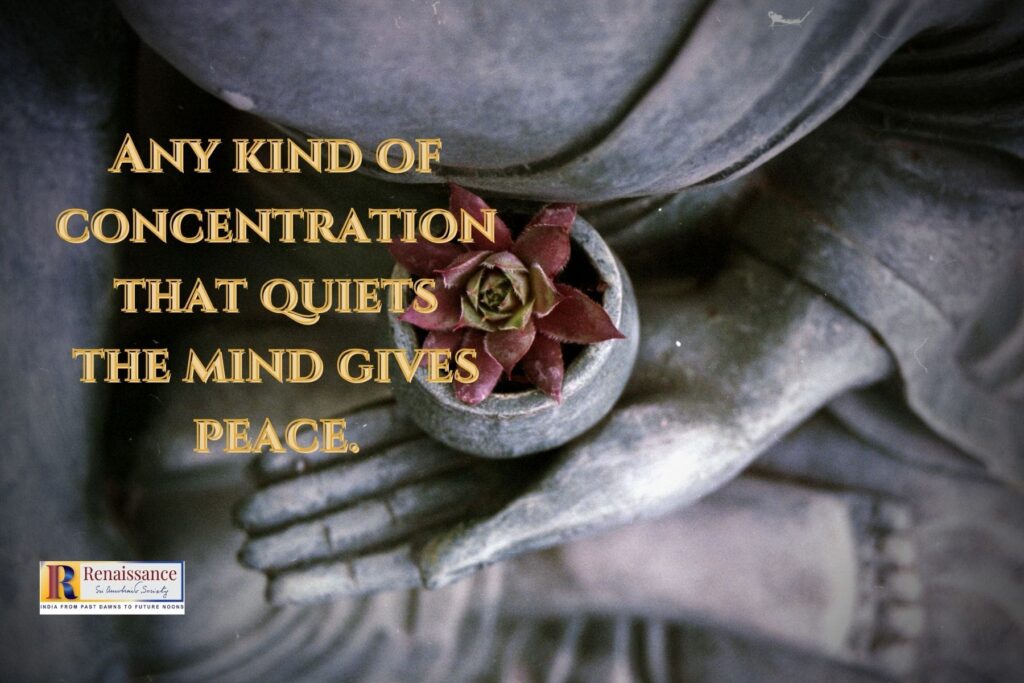
SATYENDRA (looking at N and smiling): If Nirod’s path had been of Brahmic consciousness he would have got it by now. His is of the psychic, perhaps.
NIRODBARAN: I may get it unconsciously one day.
SRI AUROBINDO: Unconsciously you may have got it already. (Laughter)
NIRODBARAN: I couldn’t quite follow the first part of your answer about the replacement of the ordinary consciousness by the spiritual.
SRI AUROBINDO: What I said was that withdrawal is not enough. The seeds of the ordinary life have also to be thrown away and one has to get the spiritual consciousness; one has to get to the true spiritual dynamism which is the source of right action.
4th March 1940, Talks with Sri Aurobindo, Vol. 2, pp. 525-528
We have come not for Peace but for Victory, because in a world governed by the hostile forces Victory must come before Peace.
~ The Mother, CWM, Vol. 15, p. 81

~ Design: Beloo Mehra

